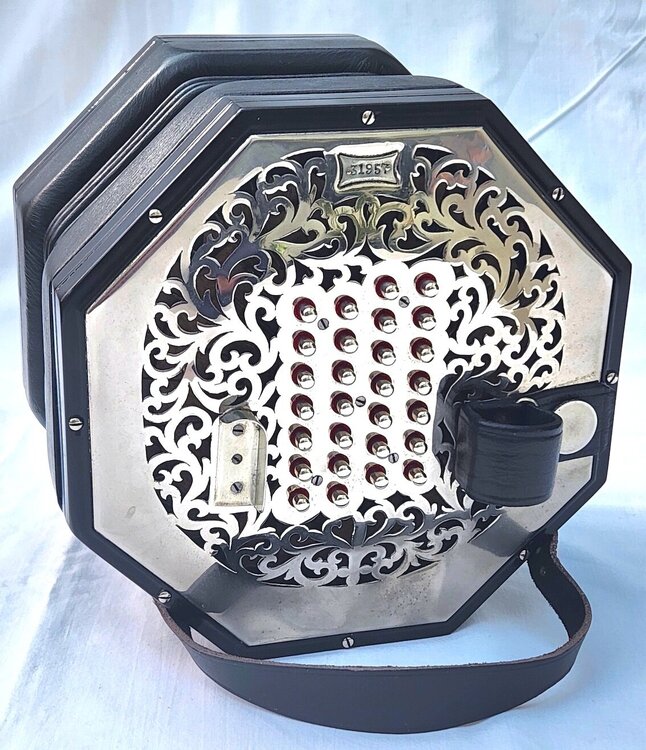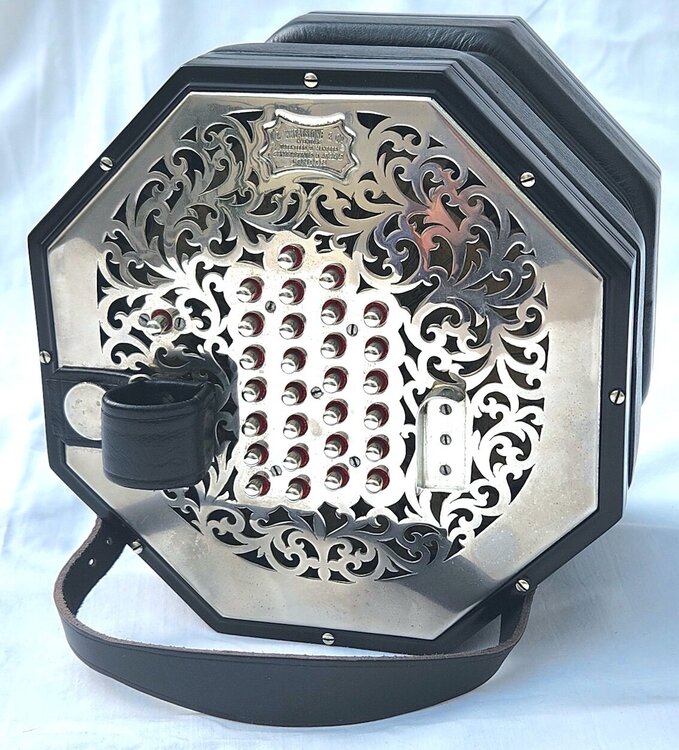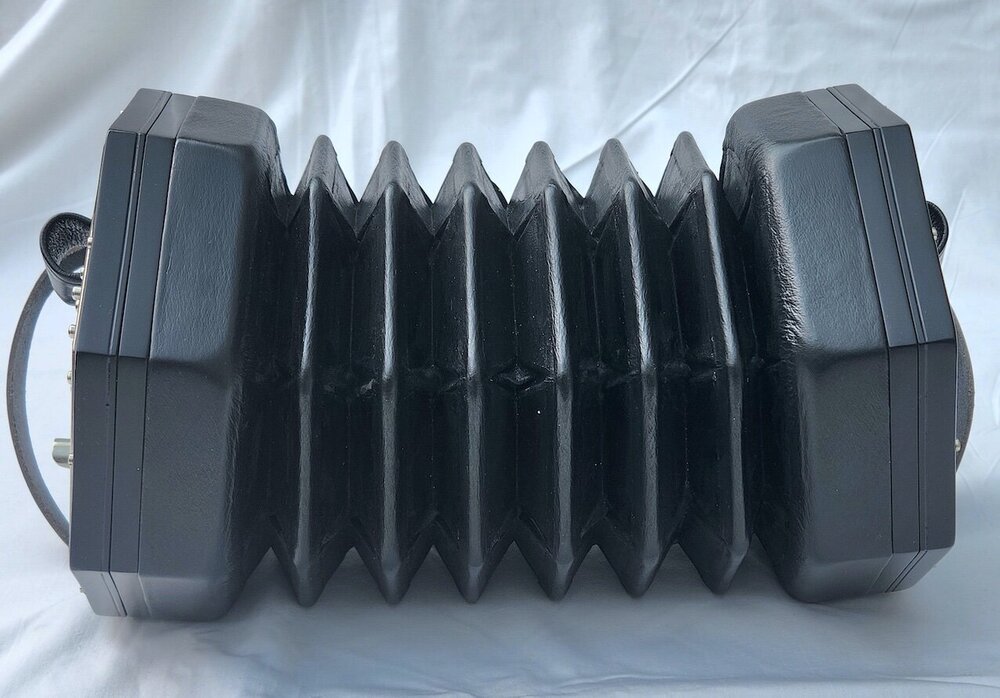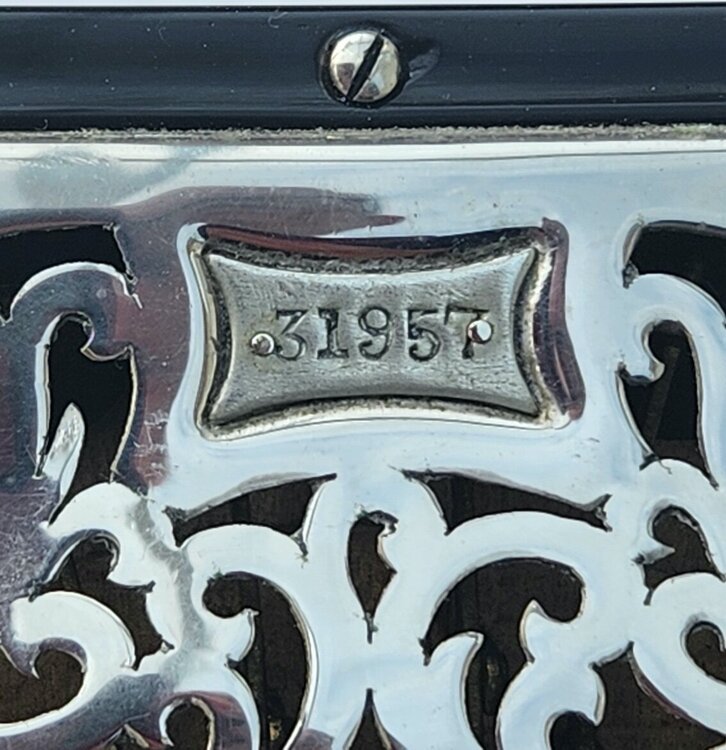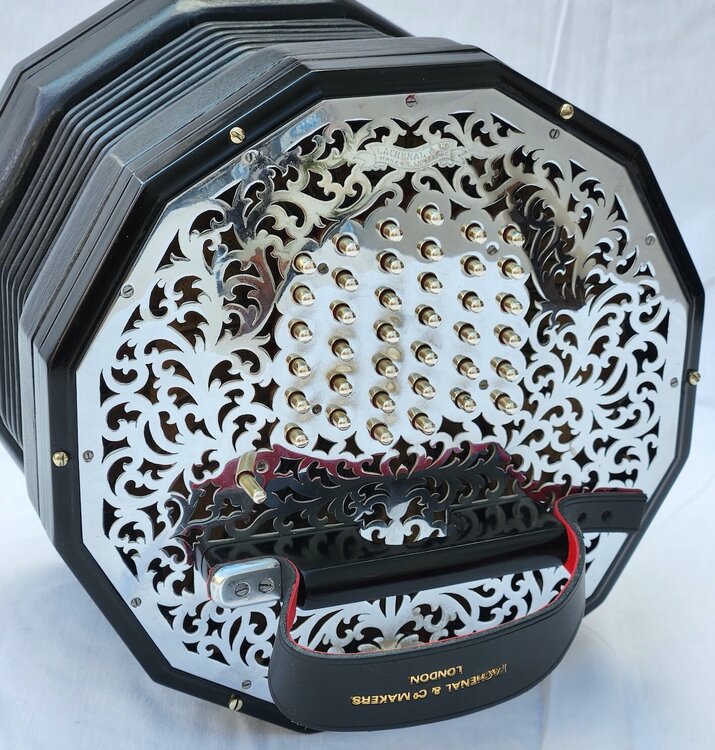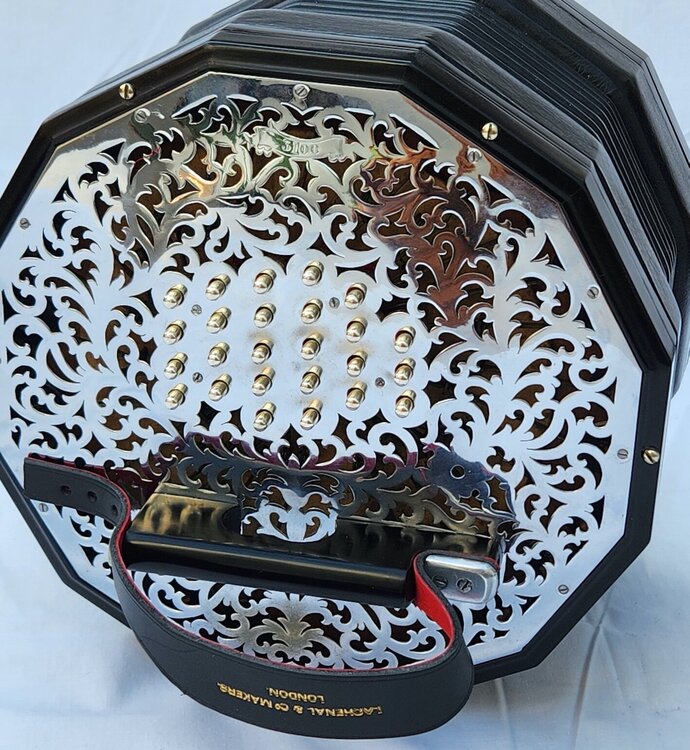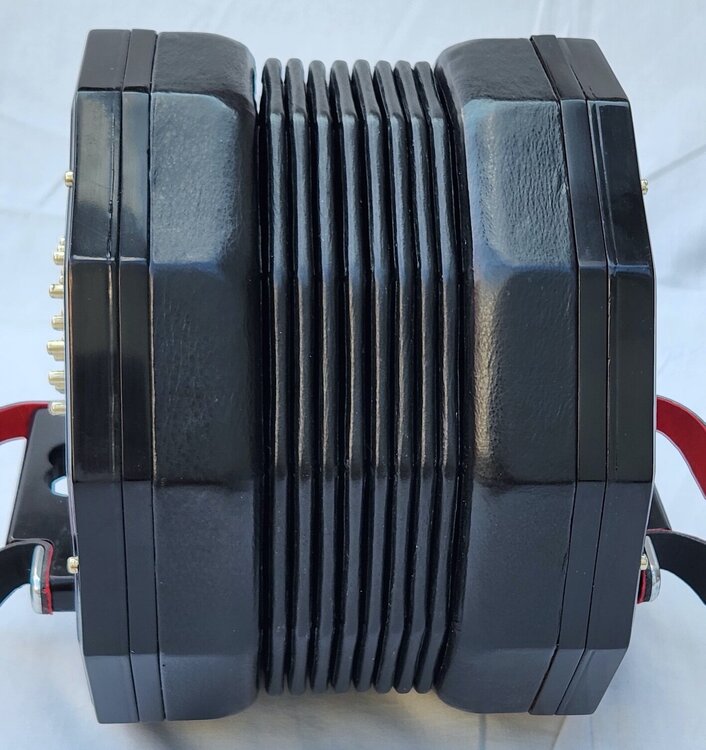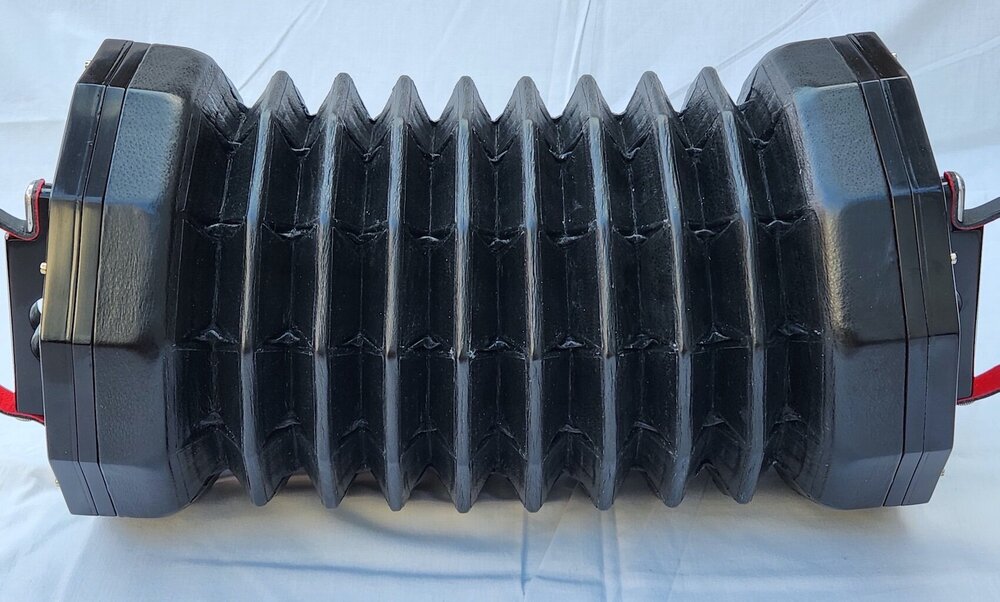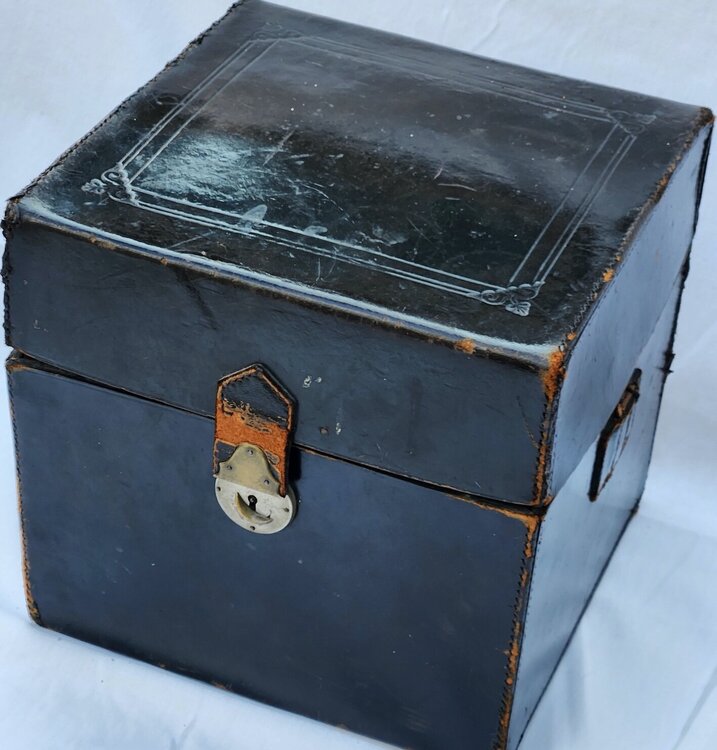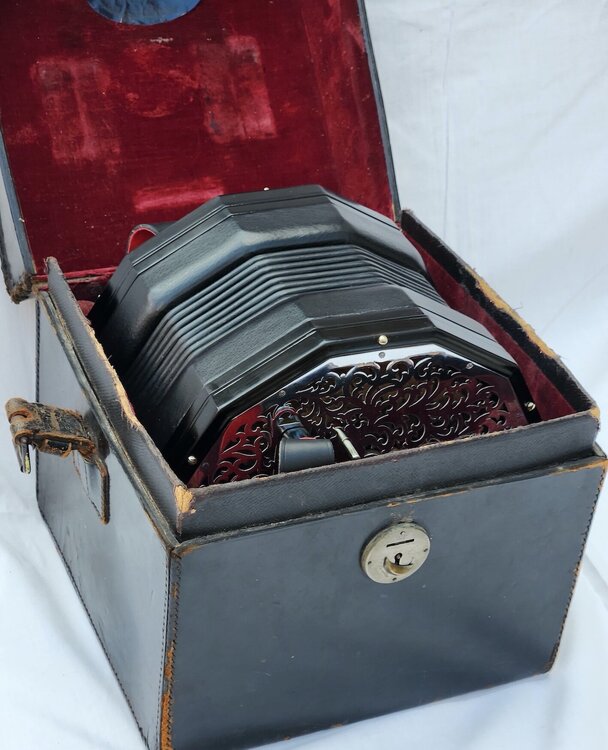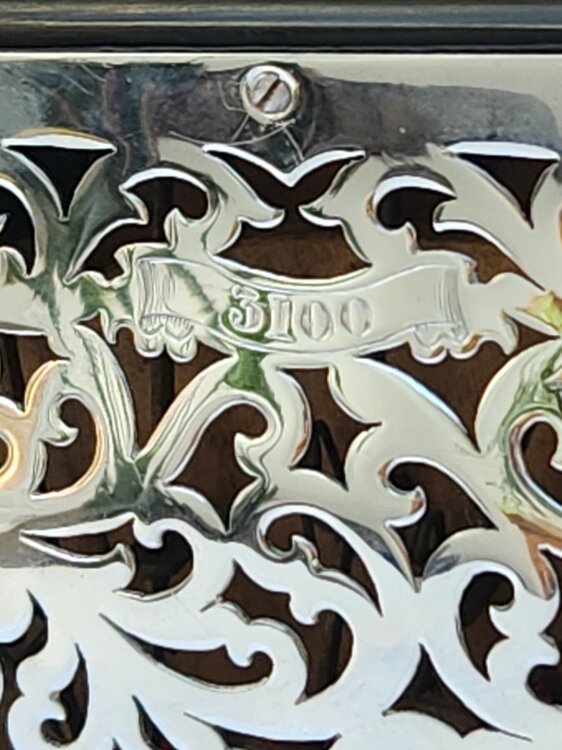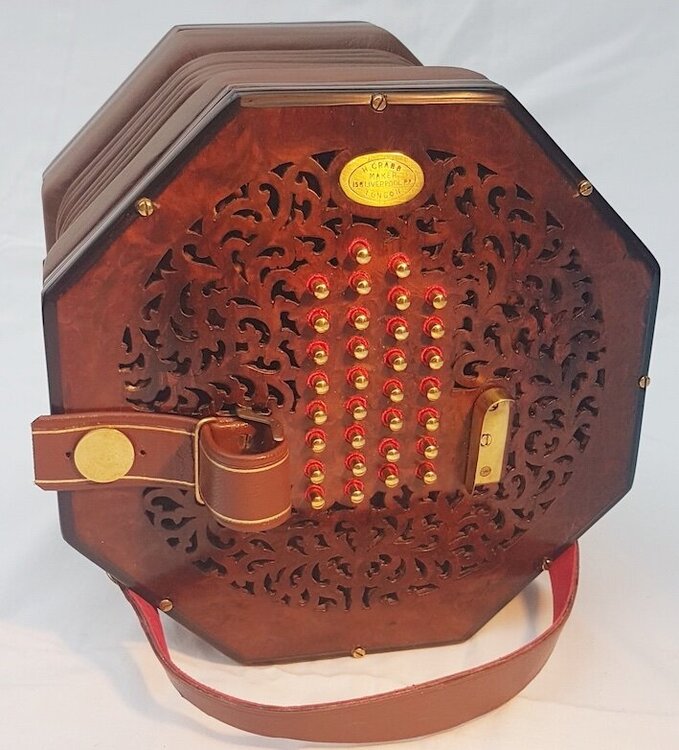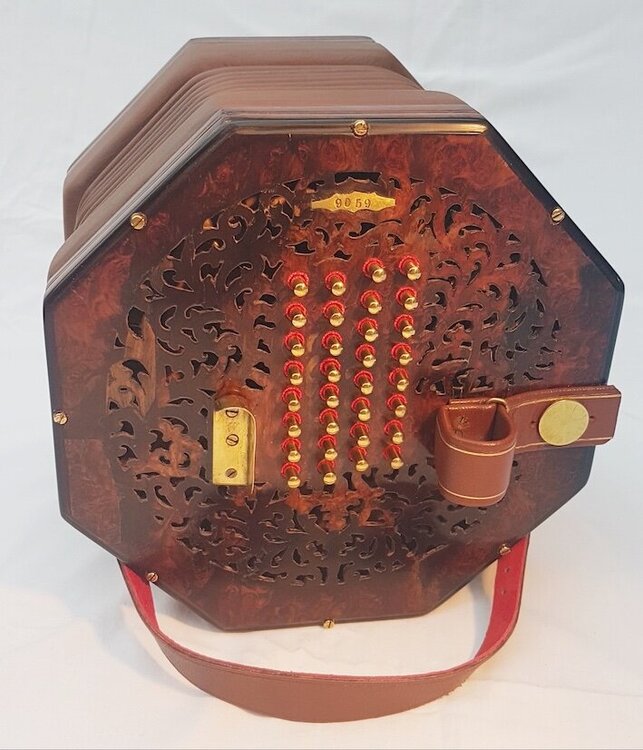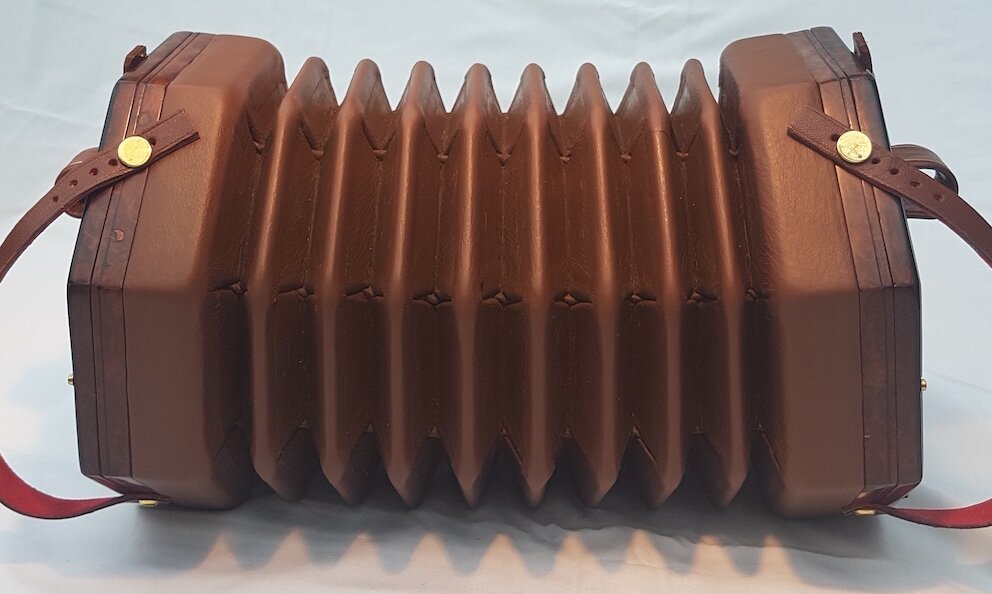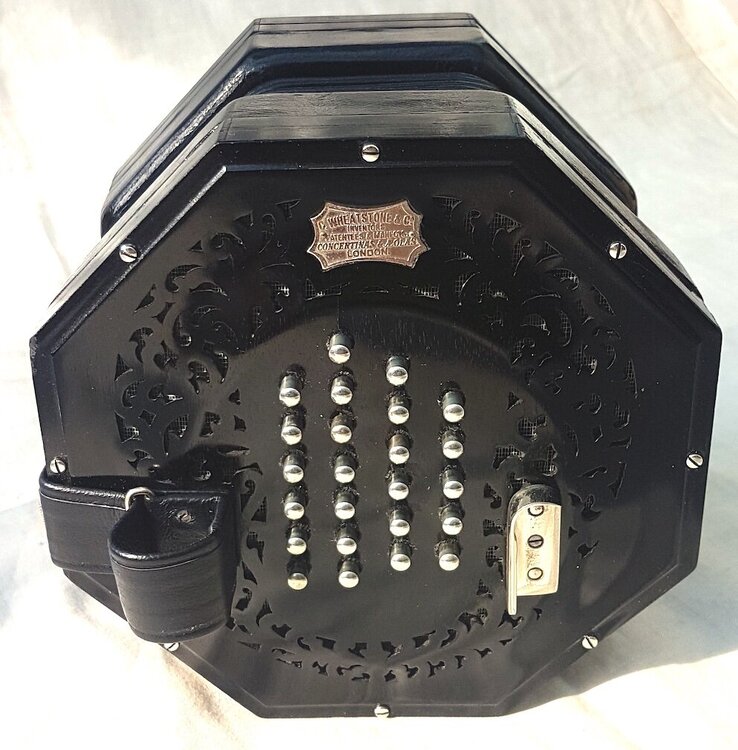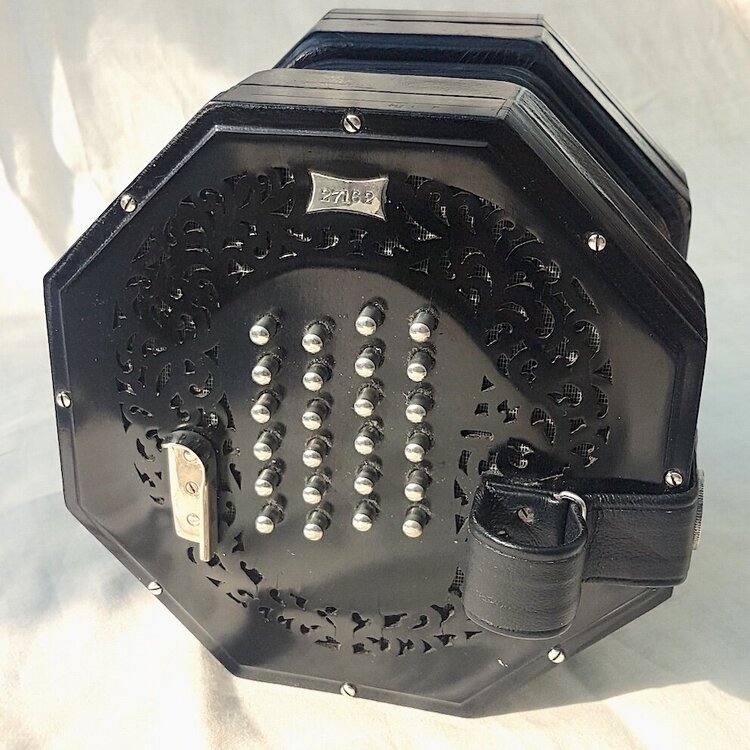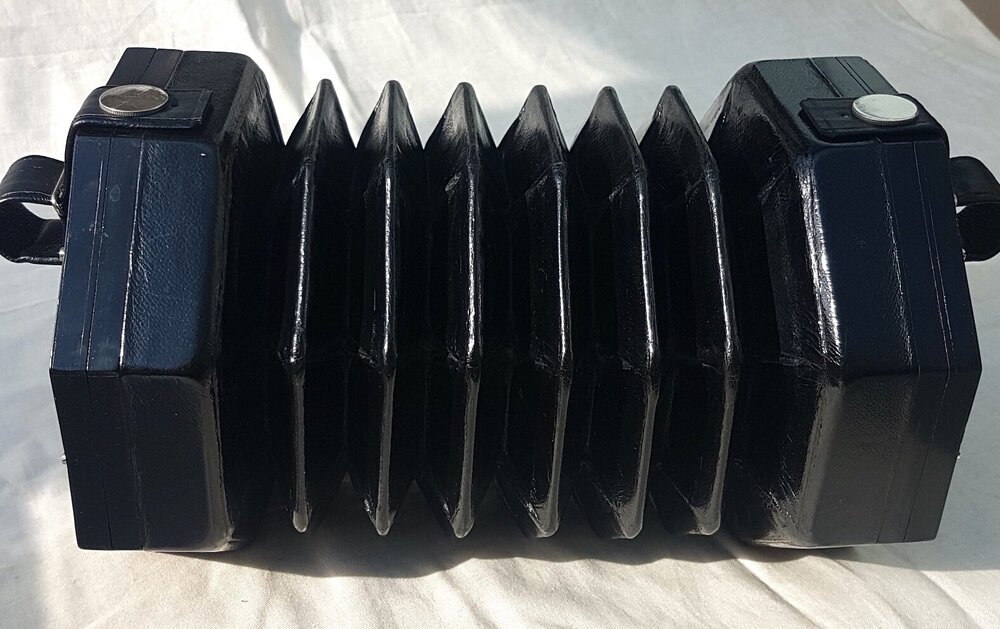
david robertson
Members-
Posts
528 -
Joined
-
Last visited
Everything posted by david robertson
-
56-key Wheatstone Aeola tenor-treble
david robertson replied to david robertson's topic in Buy & Sell
This instrument has now been sold and a donation sent to concertina.net -
A gorgeous metal-ended tenor/treble which I restored for its owner around 2 years ago, at which time it was fitted with new pads, valves, bushes, thumb-straps and wrist-straps. The bellows were given a cosmetic re-bind, and it was tuned to modern concert pitch. In the interim, the owner has decided that he hasn't got the time to improve his performance on both the concertina and the fiddle, and incomprehensibly, he has chosen the latter. Still, it's an ill wind... he offered it to me, and I snapped it up. The serial number is 31957. Now, I have heard it claimed, by someone who knows far more about Aeolas than I do (and, incidentally, has a spectacular collection of them) that Wheatstone invested in new tooling at around the 31XXX mark, and consequently, instruments in the 31000 series are among the best of the best. I can't confirm the history, but I can confirm that this one is a superb player - fast, loud and well-balanced throughout its range. One slight curiosity is that where you would normally find a low D# on the left hand, this one goes right down to Bb. It's not a common arrangement, though I have seen it before... and I love it! Price: £3350
-
Made in 1931, this is a rare example of an 8-sided Crabb, made even rarer by the amboyna veneers, gold-plated buttons and fittings, and tan leather bellows and straps. It offers a range of four and a half octaves, which includes the bottom end from a tenor-treble, and the top end from an extended treble, and it is every bit as fast and responsive as you would expect of a top-quality vintage Crabb, It has been the subject of a comprehensive restoration, with new pads, valves, bushes and springs. New wrist and thumb-straps have been fitted, the bellows have had a cosmetic re-bind, and the woodwork has been refinished in French polish. Finally, it has, of course, been tuned to Modern Concert Pitch (A=440Hz). On the minus side, the left-hand end has had some slightly agricultural repairs to the fretwork, but it is sound and solid, and I thought it better to leave honest repairs visible than to try to disguise them. (And these imperfections are reflected in the price.) It plays beautifully, and it could well be many years before you see another one like it offered for sale. As always, if you're within striking distance of Norwich, do feel free to come and have a squeeze. And if not, get in touch anyway, and we'll work something out. Price: NOW ONLY £2950
-
Here's something you don't see every day - brand new, beautifully made 8-fold bellows on an Edeophone! I bought this one from Roger Rocha of this parish about a year ago, in untouched original condition, and in pretty good order, apart from the airtight but rather shabby bellows. I thought it deserved better, so I invested the time and effort in new ones. Of course, it has had all the standard stuff done too... new pads, valves, bushes and straps, woodwork French polished and metalwork buffed up. The reeds have also been tuned to Modern Concert Pitch. (If you can see patches of orange on the ends, it's not worn plating, but simply reflections from the orange shirt I was wearing when I took the pics!) If you're looking for a big MacCann, you could be looking for quite a while before you find a better one. The asking price is £2450, and as ever, if you're within striking distance of Norwich, you're very welcome to come and have a squeeze. If you're not, get in touch anyway... I'm sure we can sort something out.
-
The 64-key Aeola has now been sold via my website, but the lovely and very original 'tropicalised' treble remains. And in view of the time it has remained, I'm offering it at a 'final reduction' price of £3000. A fine player borrowed it for a few hours, and in his words, "couldn't fault it". Sadly, his bank manager was less enthusiastic, so this is your opportunity to acquire a great Aeola at a great price. As always, if you're within reach of Norwich, come and have a squeeze. If not, call me on 07840 838899 and we'll work something out.
-
I'm afraid I can't speak for the Crabb company... but I know a man who can!
-
Curiously, I also have a similar 64-key TT Aeola on the shelf, so I have had the opportunity to compare them side by side. Both are very fast, responsive and balanced across the range. At the top end, the Crabb, to my ear at least, is actually better. But overall, it is hard to tell them apart; the Aeola is perhaps very marginally louder, the Crabb a millitad sweeter in tone. But these matters are, of course, highly subjective...
-
Made in 1931, this is a rare example of an 8-sided Crabb, made even rarer by the amboyna veneers, gold-plated buttons and fittings, and tan leather bellows and straps. It offers a range of four and a half octaves, which includes the bottom end from a tenor-treble, and the top end from an extended treble, and it is every bit as fast and responsive as you would expect of a top-quality vintage Crabb, It has been the subject of a comprehensive restoration, with new pads, valves, bushes and springs. New wrist and thumb-straps have been fitted, the bellows have had a cosmetic re-bind, and the woodwork has been refinished in French polish. Finally, it has, of course, been tuned to Modern Concert Pitch (A=440Hz). On the minus side, the left-hand end has had some slightly agricultural repairs to the fretwork, but it is sound and solid, and I thought it better to leave honest repairs visible than to try to disguise them. (And these imperfections are reflected in the price.) It plays beautifully, and it could well be many years before you see another one like it offered for sale. As always, if you're within striking distance of Norwich, do feel free to come and have a squeeze. And if not, get in touch anyway, and we'll work something out. Price: £3250
-
Quality 48-key treble by unknown maker
david robertson replied to david robertson's topic in Buy & Sell
This instrument is now sold, and a donation sent to c.net. -
Quality 48-key treble by unknown maker
david robertson replied to david robertson's topic in Buy & Sell
Thanks for the suggestion, Wes. The action on this one is quite different, though. Each pivot post is a round column of brass, with a central slot cut down from the top, in which sits the flattened section of the lever, with the rivet passing right through the column and lever. I've seen this system before, but I can't be sure who the maker was. Jabez Austin springs to mind, but as I say, there are some mornings these days when I swear I can feel the memory cells turning up their toes... -
Scates, Austin, Nickolds, Ebblewhite? Your guess is as good as mine - but in a way, it matters not a jot, because the quality is obvious everywhere, inside and out. The ends are of beautifully figured solid rosewood, with very fine inlays and unusual corner bindings of German silver. The action levers are riveted through slotted pillars (another mark of quality), and the riveted reeds are well made and close-fitting (apart from the two later additions which I have replaced). The original bellows were fit only for the bin, so I have made and fitted new 6-fold green ones, with foil-stamped '3 daisy' design papers - similar to the originals, but with a bit more bling! I have also fitted matching green leather thumb-straps, and re-covered the slides in the same leather. All pads, valves and bushes have been replaced, the woodwork has been French polished, and the reeds have been tuned to Modern Concert Pitch. It is fast and responsive, with a sweet, mellow tone - an ideal singer's instrument, I would suggest. If there's anything else I can tell you, please ask. And if you're within striking distance of Norwich, do drop in for a squeeze. Price: £1250
-
Cheffin's, Cambridge Auction: Jeffries?
david robertson replied to lea nicholson's topic in Buy & Sell
In spite of the auctioneers' supposition, it seems improbable that the bellows have been replaced by Jeffries (or, indeed, at all!) If, as Mike suggests, it's smaller than a Lachenal and looks like a Jeffries, isn't Mr Crabb the prime suspect? -
Stephen, you're right as usual - it's a marriage. The action boxes, end covers and bellows are all stamped with the serial number 1274 The reedpans have the same number, but only in handwritten form, and they are clearly not original. From the positioning of the support blocks in the bellows, it is obvious that the original reedpans were of the tapered design, with deeper chambers for the lower notes. The replacement flat pans have been adapted by gluing on little blocks of wood, of varying thickness, which correspond to the support blocks. I wondered at first why whoever fitted them didn't simply build up or move the support blocks, but I suppose it would have been easier to adjust the thickness of the blocks glued to the reedpans, rather than furtling around inside the ends of the bellows.
-
Many thanks to everyone for your suggestions. I'll post a few more pics when I've got a few minutes to spare.
-
Replacing valves? Read this first!
david robertson replied to david robertson's topic in Instrument Construction & Repair
Love to oblige, Theo, but I'm creatively drained. I may have to lie in a darkened room for a day or two... -
The glue that you use to stick soles to your shoes Is a gem of adhesive modernity. It may not be sexy, but it's tough and it's flexy - And the sole sticks from here to eternity. But what's good for shoes becomes terrible news When it's used on the valves of a 'tina. Whenever I find it, I eff it and blind it (And sometimes add something obscener!) For though it's tenacious and most efficacious, Restorers have no cause to thank it - Though we scrape and we scour for hour after hour, It still sticks like sh** to a blanket!
- 3 replies
-
- 12
-

-

-

-
Frankly, I bow to no-one in my ignorance of matters metallurgical, but I'm happy to believe that the reeds in this particular instrument are not your common-or-garden brass. In terms of tone, volume and response, I find them absolutely indistinguishable from steel.
-
Low A is slow and flat [English]
david robertson replied to DaveM's topic in Instrument Construction & Repair
A more radical diagnostic procedure is simply to bend the reed upward. If it's cracked, it will simply break along the line of the crack. -
The first of these, No.27162, is a brass-reeded treble instrument - but please don't let that deter you! These are top-quality Wheatstone brass reeds, not the gappy, breathy things found in low-end Lachenals. In terms of volume and response, they are virtually indistinguishable from steel, and this is as lively an Aeola as has ever passed through my hands. The instrument is amazingly well preserved - all I have had to do is replace the straps and tune it to modern concert pitch. I listed it over a month ago, but in view of the spontaneous outburst of indifference provoked by that listing, here it is again, with the asking price reduced to £3250. The second offering is a 64-key tenor-treble, No.28290.This one has had the more usual "full Monty" restoration - new pads, valves, bushes and straps, re-finished woodwork, a cosmetic bellows rebind, and tuning to modern concert pitch. Now I'm well aware that most people don't lie awake at night wishing they could own a concertina with those extra bat-squeak notes at the top end. But this one is a lovely player, from arguably Wheatstone's top period. And at £3250, I'm actually asking less than you would have to pay for a 56-key of similar quality. If I can tell you more about either instrument, please ask. And as always, if you're within striking distance of Norwich, you're more than welcome to come and have a squeeze. (If you're not, get in touch anyway, and we'll try to arrange something.) concertina-restoration.co.uk
-
When I buy an Aeola that's more than a century old, the first thing I usually do is to strip out and throw away all the original pads, valves and bushes. Not this time. The condition was so fine and original that I decided conservation rather than restoration should be the approach. The pads were perfectly serviceable, with no sign of the usual insect damage, so I have left well alone. The valves were in similar condition, though I have replaced a handful which had stiffened up with age and were producing an audible slap on closing. I usually like to install new red felt bushes in the button-holes... but in this case I have resisted the temptation, because the original bushes still hold the buttons in a firm embrace, with no trace of a wobble. In fact, my only interventions have been to replace the slightly shabby original straps, and to tune the instrument to modern concert pitch - and even that was not a major task, since it was tuned approximately 15 cents flat throughout, rather than the usual 50 cents sharp. One more thing. When I first took an end off this instrument, I was astonished to find it had brass reeds. Astonished, because in terms of volume and response, it is the equal of any steel-reeded Aeola that has ever passed through my hands. I'm sure you won't be disappointed. I'm asking £3250 for this one. And as always, if you're within striking distance of Norwich, you're more than welcome to come and have a squeeze.
-
I recently acquired this pretty little English treble... presumably by one of the minor makers, but which one? It has delicate German silver corner inlays, and all the corners are brass bound. The bellows papers are the gold & cream "3 daisies" pattern, the reed tongues are riveted rather than clamped, and the riveted action features slotted cylindrical pivot posts. All suggestions gratefully received.
-
This is a vintage Crabb (Geoffrey confirms it was made by his grandfather in 1911) sold by the major London music retailer Ball Beavon, whose stamp appears on the action box frame. It has the standard Crabb layout, with a C drone on the left hand. I have made and fitted new 7-fold bellows... the original 6-fold set was in as sorry a state as I have ever seen: someone had tried to make them useable by lining them with a plastic bag! In addition, I have renewed all pads, valves, bushes and straps, and tuned it to modern concert pitch. Cosmetically, the ends are not the finest. They have lost their youthful sparkle, and they show some light pitting, so for that reason I am not asking top dollar. But if performance is more important to you than pristine appearance, then this could be the one. Price: £3450
-
Thank you so much, Geoff. Stupid of me, but because of that blank cartouche, I hadn't even looked at your records! Thanks again, David
-
I wonder if I might beg a bit of help with identifying this one? It has Crabb/Jeffries style fretwork, gold tooling and papers, but is unmarked apart from the serial number 8863. I wondered if it might be an early George Jones, but it lacks the typical keyhole-shaped pivot posts. These are quite slim, and unusually sharp-pointed. The bush-boards, too, are cut out much more neatly than anything I have ever seen in a vintage Crabb or Jeffries. It's clearly an instrument of some quality, though the condition is not so much distressed as suicidal. It's the first time I've ever seen an attempt to save completely wrecked bellows by lining them with a plastic bag! Any ideas as to its origins will be most gratefully received.
-
36-key Lachenal rosewood Anglo in C/G
david robertson replied to david robertson's topic in Buy & Sell
Now sold via my website.

